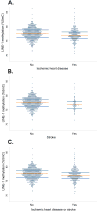Ischemic heart disease and stroke in relation to blood DNA methylation
- PMID: 20805753
- PMCID: PMC3690659
- DOI: 10.1097/EDE.0b013e3181f20457
Ischemic heart disease and stroke in relation to blood DNA methylation
Abstract
Background: Epigenetic features such as DNA hypomethylation have been associated with conditions related to cardiovascular risk. We evaluated whether lower blood DNA methylation in heavily methylated repetitive sequences predicts the risk of ischemic heart disease and stroke.
Methods: We quantified blood DNA methylation of Long Interspersed Nucleotide Element-1 (LINE-1) repetitive elements through PCR-pyrosequencing in 712 elderly individuals from the Boston-area Normative Aging Study. We estimated risk-factor adjusted relative risks (RRs) for ischemic heart disease and stroke at baseline (242 prevalent cases), and during follow-up (44 new cases; median follow-up, 63 months), as well as subsequent mortality from ischemic heart disease (86 deaths; median follow-up, 75 months).
Results: Blood LINE-1 hypomethylation was associated with baseline ischemic heart disease (RR = 2.1 [95% confidence interval = 1.2-4.0] for lowest vs. highest methylation quartile) and for stroke (2.5 [0.9-7.5]). Among participants free of baseline disease, individuals with methylation below the median also had higher risk of developing ischemic heart disease (4.0 [1.8-8.9]) or stroke (5.7 [0.8-39.5]). In the entire cohort, persons with methylation below the median had higher mortality from ischemic heart disease (3.3 [1.3-8.4]) and stroke (2.8 [0.6-14.3]). Total mortality was also increased (2.0 [1.2-3.3]). These results were confirmed in additional regression models using LINE-1 methylation as a continuous variable.
Conclusions: Subjects with prevalent IHD and stroke exhibited lower LINE-1 methylation. In longitudinal analyses, persons with lower LINE-1 methylation were at higher risk for incident ischemic heart disease and stroke, and for total mortality.
Figures
References
Publication types
MeSH terms
Grants and funding
LinkOut - more resources
Full Text Sources
Other Literature Sources
Medical


